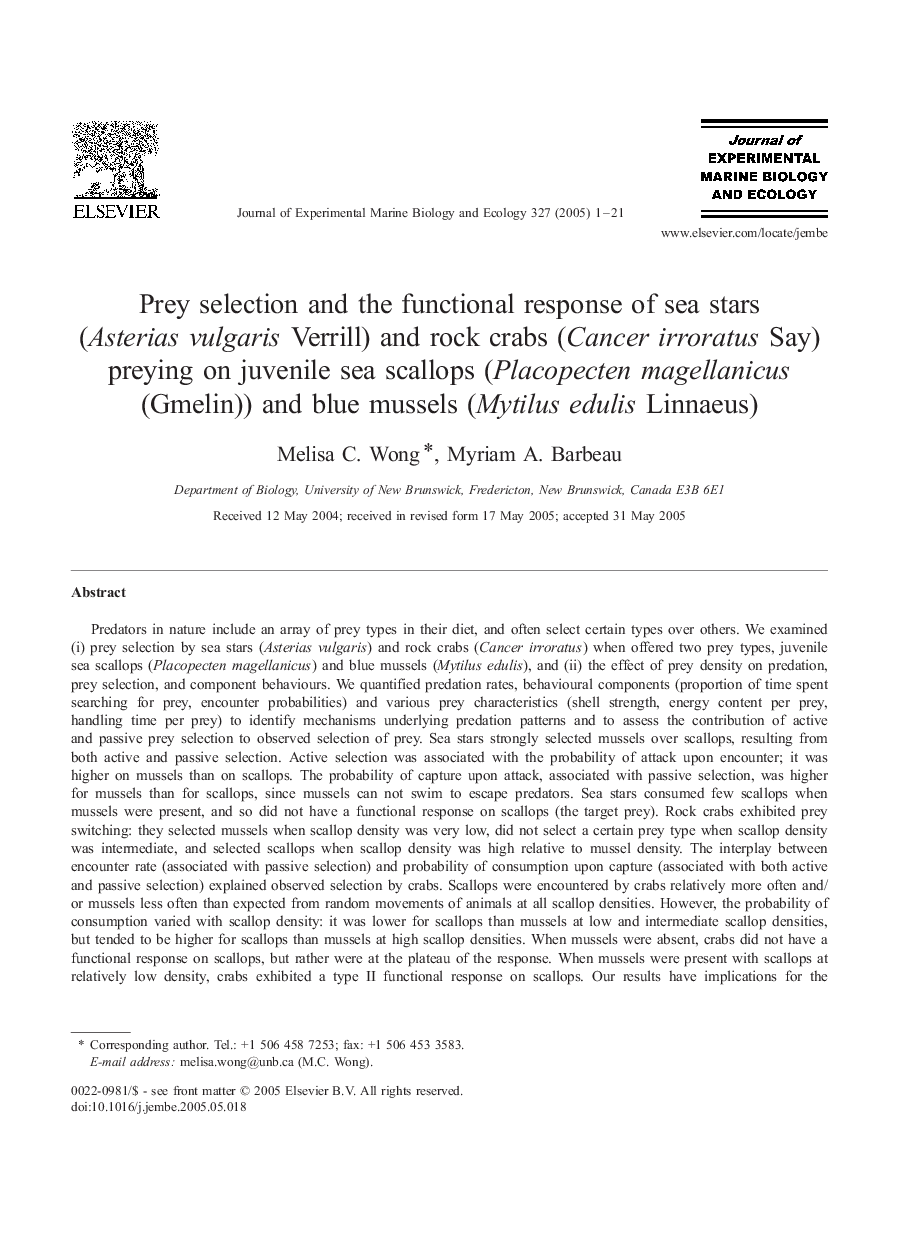| کد مقاله | کد نشریه | سال انتشار | مقاله انگلیسی | نسخه تمام متن |
|---|---|---|---|---|
| 9448665 | 1305942 | 2005 | 21 صفحه PDF | دانلود رایگان |
عنوان انگلیسی مقاله ISI
Prey selection and the functional response of sea stars (Asterias vulgaris Verrill) and rock crabs (Cancer irroratus Say) preying on juvenile sea scallops (Placopecten magellanicus (Gmelin)) and blue mussels (Mytilus edulis Linnaeus)
دانلود مقاله + سفارش ترجمه
دانلود مقاله ISI انگلیسی
رایگان برای ایرانیان
موضوعات مرتبط
علوم زیستی و بیوفناوری
علوم کشاورزی و بیولوژیک
علوم آبزیان
پیش نمایش صفحه اول مقاله

چکیده انگلیسی
Predators in nature include an array of prey types in their diet, and often select certain types over others. We examined (i) prey selection by sea stars (Asterias vulgaris) and rock crabs (Cancer irroratus) when offered two prey types, juvenile sea scallops (Placopecten magellanicus) and blue mussels (Mytilus edulis), and (ii) the effect of prey density on predation, prey selection, and component behaviours. We quantified predation rates, behavioural components (proportion of time spent searching for prey, encounter probabilities) and various prey characteristics (shell strength, energy content per prey, handling time per prey) to identify mechanisms underlying predation patterns and to assess the contribution of active and passive prey selection to observed selection of prey. Sea stars strongly selected mussels over scallops, resulting from both active and passive selection. Active selection was associated with the probability of attack upon encounter; it was higher on mussels than on scallops. The probability of capture upon attack, associated with passive selection, was higher for mussels than for scallops, since mussels can not swim to escape predators. Sea stars consumed few scallops when mussels were present, and so did not have a functional response on scallops (the target prey). Rock crabs exhibited prey switching: they selected mussels when scallop density was very low, did not select a certain prey type when scallop density was intermediate, and selected scallops when scallop density was high relative to mussel density. The interplay between encounter rate (associated with passive selection) and probability of consumption upon capture (associated with both active and passive selection) explained observed selection by crabs. Scallops were encountered by crabs relatively more often and/or mussels less often than expected from random movements of animals at all scallop densities. However, the probability of consumption varied with scallop density: it was lower for scallops than mussels at low and intermediate scallop densities, but tended to be higher for scallops than mussels at high scallop densities. When mussels were absent, crabs did not have a functional response on scallops, but rather were at the plateau of the response. When mussels were present with scallops at relatively low density, crabs exhibited a type II functional response on scallops. Our results have implications for the provision of protective refuges for species of interest (i.e., scallops) released onto the sea bed, such as in population enhancement operations and bottom aquaculture.
ناشر
Database: Elsevier - ScienceDirect (ساینس دایرکت)
Journal: Journal of Experimental Marine Biology and Ecology - Volume 327, Issue 1, 20 December 2005, Pages 1-21
Journal: Journal of Experimental Marine Biology and Ecology - Volume 327, Issue 1, 20 December 2005, Pages 1-21
نویسندگان
Melisa C. Wong, Myriam A. Barbeau,